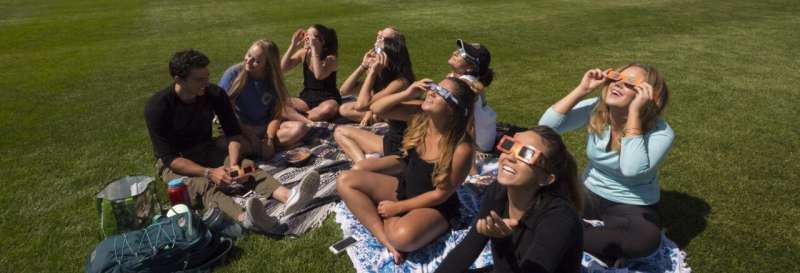This article has been reviewed according to Science X's editorial process and policies. Editors have highlighted the following attributes while ensuring the content's credibility:
fact-checked
trusted source
proofread
Q&A: A 'ring of fire' eclipse is coming. Here's how to watch

At about 10:30 a.m. Mountain Time on Saturday, Oct. 14, the moon will pass in front of the sun above much of the western U.S., creating a blazing "ring of fire" in the sky.
The event is called an annular eclipse, and it will be the first of two eclipses that North America will witness in the coming year. In April 2024, a total solar eclipse, in which the moon will completely block the face of the sun, will similarly cross over a swath of the country.
Boulder doesn't lie in the path of the full October eclipse, but Colorado residents can still see an impressive partial eclipse, said John Keller, director of the Fiske Planetarium at CU Boulder. The planetarium will host a viewing party open to the public on the Norlin Quad from 9:30 a.m. to noon as part of CU Boulder's Family Weekend.
Keller is co-director of outreach for NASA's Polarimeter to UNify the Corona and Helioshpere (PUNCH). The effort will send four small spacecraft to explore the solar wind, or the radiation that streams from the sun on a near-constant basis. He gave his take on what Coloradans can expect during the upcoming eclipse, and how these astronomical events have drawn in humans for millennia. He also shared tips for viewing these events safely.
"You should never look at the sun at any point without eye protection in the form of solar viewing glasses during the October annular eclipse," Keller said.
To learn more about the science of eclipses, watch the video series Science through Shadows from the Fiske Planetarium.
This is going to be an exciting week for astronomy in the western U.S. What's in store for star gazers?
With an annular eclipse, the moon looks ever-so-slightly smaller than what you'd see during a total eclipse, so the moon will not fully block the sun. You'll see an annulus, or a "ring of fire," around the sun.
Where can we see the eclipse?
The annular eclipse will first hit landfall in Oregon, then pass down through Nevada and Utah and right through the Four Corners area of New Mexico, Arizona, Colorado and Utah. It will continue to Texas and then out to the Caribbean.
If you're outside that path like we are in Boulder, you'll see a partial eclipse where a part of the sun will be blocked by the moon.
How rare are these events?
Eclipses happen roughly twice a year somewhere on the globe. But for any given location, they usually appear once a decade or even less often than that. We were lucky enough to have a total eclipse in 2017 that passed over the United States, and there will be another total eclipse in April 2024. But the next total eclipse passing the contiguous United States will not be until the 2044.What will happen during next year's total eclipse?
In April 2024, we will have a total eclipse of the sun. Unlike an annular eclipse, the moon will fully block the sun during this event. It will start in Mazatlán, Mexico, passing up to Texas and Arkansas, through south Detroit and all the way to Maine and Nova Scotia. We'll be able to see a partial eclipse in Boulder.
Interestingly, eclipses always travel from west to east because they're caused by the motion of the of the moon going from west to east in its orbit around our planet.
What kinds of observations can astronomers make during an eclipse?
Total eclipses of the sun provide a unique opportunity for us to study the sun's corona, or outer atmosphere, from the ground. The corona is about one million times fainter than the solar disk, so you need to fully block the disk to see it. You can see electrons streaming off the sun creating what we call the solar wind.
Those electrons eventually get to Earth and can cause things like the aurora borealis, or northern lights, and can affect satellites, power grids and communications.
In that sense, today's scientists are taking part in a very old tradition. How so?
People have been observing eclipses for tens of thousands of years. We have evidence going back to Chaco Canyon 1,000 years ago of ancient sun watching. This is a unique opportunity for everybody in the United States to experience the sun in the same ways that humans have for thousands of years. It's a common theme of humanity.
You mentioned astronomy in Chaco Canyon, the site of an Ancestral Puebloan society located in modern-day New Mexico. What do we know about how they watched the skies?
The Ancestral Puebloans, and modern Native American groups today, have a long history of sun-watching and observing the sky. In Chaco Canyon, there are a number of petroglyphs that appear to document astronomical phenomena. There's one rock called "Rock of the Sun." On its south face, we can see a unique petroglyph unlike anything else in the canyon. One possible interpretation is that it could represent the moon blocking the sun with the corona visible.
There was a total eclipse that passed over Chaco Canyon in the year 1097, when the sun would have been at a maximum, a time when solar storms called coronal mass ejections are more common. It's possible this petroglyph is documenting that 1097 event.
What's so special about seeing an eclipse?
Oftentimes, people will feel less significant when observing an eclipse. It's actually the opposite for me. It helps me realize that I'm part of a much bigger thing. That's a unique perspective—knowing that I'm a small part of a much bigger cosmic perspective.
Provided by University of Colorado at Boulder




















